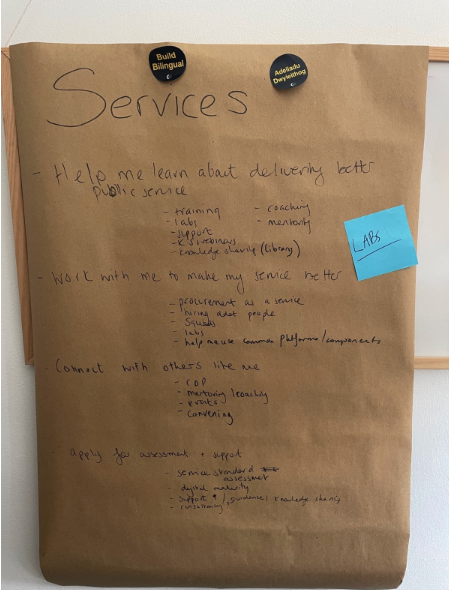Every organisation is a service organisation.
The best service organisations design their services to meet the needs of their users.
At CDPS, we have been undergoing a quiet revolution. We’ve been transforming ourselves into a service organisation.
We’re continuing to work in the open so others may learn from our experiences. After all, we’re only asking all public service organisations in Wales to do the same, so best we go first!
When trying to get things done, it’s easy to work in familiar ways without realising there may be a better way. In growing so rapidly (from 5 to over 50 employees) over the last 2 years and trying to get everything we wanted to achieve done, we realised we had begun to form hierarchical teams, specialised in certain skills – a communications team, an operations team, a delivery team, a skills team and a user-centred design team. While this structure felt natural in the beginning, it wasn’t the best way to structure ourselves to meet the needs of our users.
When we were a much smaller organisation, we were able to work closely across different areas and keep up with what was going on, but with growth, came the start of teams working on their own work and less time to talk with others about what they were doing and learning.
We weren’t siloed – we were a young organisation and we made great efforts to keep in touch. We used Slack for messaging, published weeknotes, ran regular show and tells, held governance meetings, and wrote blog posts.
We were teaching people in our training sessions and showing people within our delivery projects, the benefits of working in multidisciplinary teams, of funding teams, not projects, and above all, making your services meet your users’ needs, and we ourselves were falling into the trap of structuring ourselves around our teams and organisational needs and not around the services we were providing to our users.
We needed to better align our teams with our services, and those services to better align with our users’ needs.
We started thinking about how we described what we do to others in simple terms and how we talked about what CDPS can help people achieve.
We even wondered how we would describe ourselves to our grandparents in terms that they’d understand.
We looked at ourselves from our users’ point of view and came up with 4 areas, becoming the first iteration of our service offering to support organisations to improve public services:
-
learning (training, webinars, resources)
-
working with us (squads of digital experts)
-
connecting with others (events, communities of practice)
-
service assessment and support (the Digital Service Standards for Wales)

Our first iteration of how we could help improve digital services.
We then began to think about these in more detail. Some of the services were relatively mature and others were just ideas.
What did we do?
We engaged a service designer to support with this work.
They listed our strategic priorities and scored each of the activities from our roadmap against them. They then calculated which ones contributed most and least to our priorities.
The results were aligned with the service names we were beginning to define, so we could see which activities contributed to each service and how they were aligned with our strategic priorities.
We refined our language – we were a service organisation and the activities we offered were actually products within the services.
We were able to see which products contributed most to each service and which ones contributed to more than one service.
Putting ourselves in the position of our users, we settled on the following services:
I want CDPS to help me to:
-
design and improve my digital service
-
learn digital skills
-
meet the Digital Service Standards for Wales
-
connect with other digital professionals
What’s next?
Our next blog post will look at what this means for existing teams in CDPS as well as how each of the services are meeting user needs.